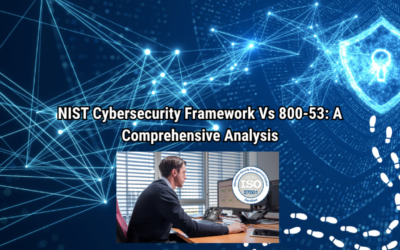In the ever-evolving business landscape, organizations are required to implement management systems that help improve operational efficiency, ensure compliance, and meet customer expectations. Two of the most widely recognized international standards that support these goals are ISO 27001 vs ISO 9001. Although both are vital for modern businesses, they focus on different aspects of management ISO 27001 is concerned with information security management, while ISO 9001 is focused on quality management.
While both of these certifications contribute significantly to organizational growth and resilience, their purposes, structures, and methodologies are different. This article will provide an in-depth comparison of ISO 27001 vs. ISO 9001, highlighting the differences, similarities, and the benefits organizations can derive from implementing them.
What is ISO 27001?
ISO 27001 vs ISO 9001 is the international standard for Information Security Management Systems (ISMS). It provides a systematic approach to managing sensitive company information, ensuring its confidentiality, integrity, and availability through the implementation of robust security controls. Organizations that adopt ISO 27001 are required to establish, implement, operate, monitor, review, maintain, and improve their ISMS to ensure the protection of their data and other valuable assets.
ISO 27001 covers the following aspects of information security:
- Confidentiality: Ensuring that data is only accessible to those authorized to access it.
- Integrity: Ensuring that data is accurate and trustworthy.
- Availability: Ensuring that information is accessible when required by authorized users.
The standard outlines a framework for identifying risks to sensitive information and provides a set of control objectives to mitigate these risks. The primary goal of ISO 27001 is to reduce information security risks by ensuring that businesses take a proactive and structured approach to managing security incidents, data breaches, and other threats.
What is ISO 27001 vs ISO 9001?
ISO 27001 vs ISO 9001 is the international standard for Quality Management Systems (QMS). It is designed to help organizations improve their overall quality by ensuring that products and services consistently meet customer requirements and comply with relevant regulations. The ISO 9001 standard focuses on improving operational processes, fostering a culture of continuous improvement, and increasing customer satisfaction.
ISO 9001 has a broader application than ISO 27001, as it can be applied to any organization that aims to enhance quality, regardless of industry or size. The standard provides a framework for organizations to establish a set of quality objectives, implement controls, measure performance, and improve their processes to meet customer expectations.
Key principles of ISO 9001 include:
- Customer Focus: Ensuring that customer needs and expectations are understood and met.
- Leadership: Establishing clear direction and fostering a culture of quality.
- Engagement of People: Encouraging involvement at all levels to improve quality outcomes.
- Process Approach: Managing and optimizing processes to achieve desired outcomes.
- Improvement: Continuously improving processes, products, and services.
- Evidence-based Decision Making: Making decisions based on accurate data and analysis.
- Relationship Management: Developing and managing relationships with suppliers and partners.
Key Differences Between ISO 27001 and ISO 9001

While both ISO 27001 and ISO 9001 share a focus on improving business operations, the standards have distinct purposes, structures, and scopes. Below are the key differences between the two:
1. Core Focus
- ISO 27001: The focus of ISO 27001 is on information security. It addresses how organizations can protect sensitive data, such as personal data, financial records, intellectual property, and business-critical information, from unauthorized access, loss, or damage. The goal is to ensure that information security risks are properly identified, assessed, and mitigated through the implementation of robust controls.
- ISO 9001: The primary focus of ISO 9001 is on quality management. It ensures that organizations deliver products and services that meet customer needs, comply with regulations, and improve customer satisfaction. The goal is to improve overall operational efficiency and ensure that products and services are consistently produced to the required quality standards.
2. Scope of Application
- ISO 27001 is particularly relevant to organizations that handle sensitive information, such as healthcare institutions, financial services companies, government agencies, and IT service providers. It is most commonly adopted by businesses concerned with safeguarding their data from security breaches, cyberattacks, and other types of threats.
- ISO 9001, on the other hand, is a universal standard applicable to any organization, regardless of its size, industry, or geographical location. It is adopted by organizations that want to improve the quality of their products or services, enhance customer satisfaction, and streamline business processes.
3. Risk Management Approach
- ISO 27001 uses a risk-based approach to identify, assess, and treat risks associated with information security. Organizations must conduct risk assessments, identify potential threats, and put in place controls to mitigate risks to the security of their information. This approach ensures that businesses prioritize and address the most significant security threats first.
- ISO 9001, while also adopting a risk-based approach, focuses on managing risks that could affect the quality of products and services. The standard encourages businesses to consider risks related to production processes, customer satisfaction, regulatory compliance, and supply chain management. Risk management in ISO 9001 is aimed at ensuring consistent product or service quality, as well as customer satisfaction.
4. Documentation and Record-Keeping
- ISO 27001 requires extensive documentation to support the implementation and operation of the ISMS. This includes documenting the risk assessment process, security policies, security controls, access management procedures, and incident response plans. Record-keeping is essential for ensuring compliance with the standard and demonstrating that the ISMS is effectively managed.
- ISO 9001 also requires documentation, but the focus is on quality control and product/service consistency. Documentation is used to track processes, customer feedback, and performance metrics, ensuring that quality objectives are met and product/service quality is maintained. The standard also requires documentation of corrective and preventive actions taken to address non-conformities.
5. Certification Process
While the certification process for both ISO 27001 and ISO 9001 follows similar steps, the specifics of the process differ:
- ISO 27001 requires organizations to conduct a comprehensive risk assessment and implement an ISMS based on the identified risks. Once the ISMS is in place, the organization must conduct internal audits, corrective actions, and undergo a certification audit by an accredited third-party certification body.
- ISO 9001 requires organizations to implement a quality management system based on customer requirements, regulatory compliance, and continuous improvement principles. Once the system is established, businesses must perform internal audits, take corrective actions, and undergo a certification audit to demonstrate compliance with the ISO 9001 standard.
6. Continuous Improvement
- Both ISO 27001 and ISO 9001 stress the importance of continuous improvement, though in different areas:
- ISO 27001 requires ongoing reviews of the ISMS to address emerging security threats, technological advances, and changes in legal or regulatory requirements. This helps ensure that the organization’s information security controls remain effective over time.
- ISO 9001 promotes continuous improvement of quality management processes to ensure products and services consistently meet customer expectations and comply with regulatory standards. Organizations are encouraged to gather feedback from customers, monitor key performance indicators, and implement improvements to maintain quality standards.
Commonalities Between ISO 27001 and ISO 9001
Despite their differences, ISO 27001 and ISO 9001 share several key similarities, particularly in terms of their approach to management systems:
1. Management System Structure

Both ISO 27001 and ISO 9001 follow the Plan-Do-Check-Act (PDCA) model, which is a structured approach to continuous improvement. This model encourages organizations to:
- Plan: Establish objectives, processes, and policies.
- Do: Implement the plans and operate processes.
- Check: Monitor and measure performance.
- Act: Take corrective actions and continuously improve processes.
2. Risk Management
Both standards incorporate risk management as a fundamental principle, although they apply it in different contexts. In ISO 27001, risk management focuses on information security threats, while in ISO 9001, it focuses on quality-related risks. Both standards require organizations to assess and address risks to improve their overall performance.
3. Focus on Customer Satisfaction
While ISO 27001 focuses on securing customer data and ensuring privacy, ISO 9001 focuses directly on meeting customer needs by ensuring product/service quality. Both standards ultimately aim to improve customer satisfaction through improved organizational processes and controls.
4. Documentation and Record-Keeping
Both ISO 27001 and ISO 9001 emphasize the need for detailed documentation and record-keeping to ensure compliance, track performance, and facilitate audits. Both standards require regular reviews and updates to documentation to ensure that it remains current and relevant.
Integrating ISO 27001 and ISO 9001
In many cases, organizations choose to implement both ISO 27001 and ISO 9001 simultaneously to benefit from both quality management and information security frameworks. This integrated approach allows businesses to:
- Enhance efficiency: By aligning the management systems, businesses can streamline their processes and reduce duplication.
- Simplify audits: Joint audits for both ISO 27001 and ISO 9001 can reduce costs and minimize disruption.
- Achieve comprehensive risk management: Organizations can address both quality and information security risks within a single management framework.
Conclusion
In summary, ISO 27001 and ISO 9001 are two highly regarded standards that focus on different areas of business management: ISO 27001 targets information security and the protection of sensitive data, while ISO 9001 focuses on maintaining and improving quality management systems.
Both certifications share a focus on risk management, continuous improvement, and customer satisfaction. However, they have distinct applications, processes, and areas of emphasis. ISO 27001 is particularly valuable for organizations that need to manage information security risks, while ISO 9001 is applicable to any organization aiming to enhance quality and operational efficiency.



0 Comments